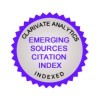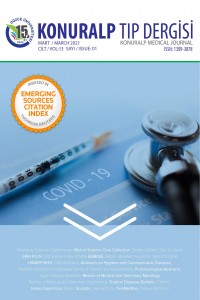Is it possible to predict mortality using initial data of adult patients hospitalized with COVID-19? A mortality prediction model in the early phase of COVID-19
Abstract
Objective: In this study, we aimed to determine the factors that contribute to the early determination of mortality risk in patients hospitalized with COVID-19.
Methods: We included 941 adult inpatients (474 male [50.4%], mean age, 53.5±17.0. The patients were divided into two groups: the discharge group and the death group. Epidemiological data, medical history, underlying comorbidities, laboratory findings, chest computed tomographic scans, real-time reverse transcription-polymerase chain reaction detection results, and survival data were obtained with retrospective recordings on admission and follow-up. The statistical relationship between survival data and parameters was analyzed. A mathematical model was created from the data of both groups.
Results: While 863 patients survived, 78 were non-survivors. During the study period, the preliminary case fatality rate of the inpatients was 8.3%. The mean age of the non-survivors was 71.7±11.2 SD ( P <0.001). Laboratory findings showed that mortality was high in those with high D-dimer, sodium, lactate dehydrogenase (LDH), troponin, creatine kinase-myocardial band (CK-MB), ferritin, blood lactate, activated partial thromboplastin time, and high blood glucose levels ( P <0.05). Furthermore, mortality was high in patients with low albumin, lymphocyte, and platelet levels ( P <0.05). The logistic regression model showed that advanced age, hypertension, high d-dimer (>1000 ng/ml), high C-reactive protein (CRP), CK-MB, and LDH, and low lymphocyte count were associated with poor prognosis.
Conclusion: According to week 1 data of patients with COVID-19, advanced age, hypertension, d-dimer, CRP, CK-MB, high LDH, and low lymphocyte were associated with poor prognosis. We believe that this model will be useful in predicting patient mortality.
Keywords
References
- References 1. Kobayashi T, Jung S-M, Linton NM, Kinoshita R, Hayashi K, Miyama T, et al. Communicating the Risk of Death from Novel Coronavirus Disease (COVID-19). J Clin Med Res 2020;9. https://doi.org/10.3390/jcm9020580. 2. Jin H, Liu J, Cui M, Lu L. Novel coronavirus pneumonia emergency in Zhuhai: impact and challenges. Journal of Hospital Infection 2020;104:452–3. https://doi.org/10.1016/j.jhin.2020.02.005.
COVID-19 Tanısıyla Hastaneye Yatırılan Yetişkin Hastaların İlk Verilerini Kullanarak Ölüm Oranını Tahmin Etmek Mümkün Müdür? COVID-19'un Erken Evresinde Bir Ölüm Tahmin Modeli
Abstract
Amaç: Bu çalışmada COVID-19 tanısıyla hastaneye yatırılan hastalarda mortalite riskinin erken dönemde belirlenmesine katkıda bulunan faktörleri belirlemeyi amaçladık.
Yöntem: Hastanede yatan 941 COVID-19 tanılı erişkin hasta (474 erkek [% 50.4], yaş ortalaması 53.5 ± 17 çalışmaya dahil edildi. Hastalar taburcu edilenler ve mortal seyredenler olarak iki gruba ayrıldı. Epidemiyolojik veriler, tıbbi öykü, altta yatan komorbiditeler, laboratuvar sonuçları, akciğer bilgisayarlı tomografi görüntüleri, PCR sonuçları, sağkalım verileri, başvuru ve takipte geriye dönük olarak kaydedildi. Sağkalım verileri ile parametreler arasındaki istatistiksel ilişki incelendi.Her iki grup verilerinden matematiksel bir model oluşturuldu.
Bulgular: 863 hasta hayatta kalırken, 78 hasta mortal seyretti. Çalışma süresi boyunca, yatan hastaların ilk vaka ölüm oranı % 8.3 idi. Mortal grupta hastaların ortalama yaşı 71.7 ± 11.2 SD idi (P <0.001). Laboratuvar bulgularında, D-Dimer, sodyum, laktat dehidrojenaz (LDH), troponin, kreatin kinaz-miyokardiyal bant (CK-MB), ferritin, kan laktat, aktive parsiyel tromboplastin zamanı ve kan şekeri düzeyleri yüksek olanlarda ölüm oranının yüksek olduğu tespit edilmiştir (P <0.05). Ayrıca; albümin, lenfosit ve trombosit düzeyi düşük hastalarda da mortalite yükse saptandı (P <0.05). Lojistik regresyon modeli, ileri yaş, hipertansiyon, yüksek D-Dimer (> 1000 ng / ml), yüksek C-reaktif protein (CRP), CK-MB ve LDH ve düşük lenfosit sayısının kötü prognozla ilişkili olduğunu gösterdi.
Sonuç: COVID-19 hastalarının 1. hafta verilerine göre ileri yaş, hipertansiyon, yüksek D-Dimer, CRP, CK-MB, LDH ve düşük lenfosit kötü prognozla ilişkilendirildi. Bu modelin hasta ölümlerini tahmin etmede faydalı olacağına inanıyoruz.
Keywords
References
- References 1. Kobayashi T, Jung S-M, Linton NM, Kinoshita R, Hayashi K, Miyama T, et al. Communicating the Risk of Death from Novel Coronavirus Disease (COVID-19). J Clin Med Res 2020;9. https://doi.org/10.3390/jcm9020580. 2. Jin H, Liu J, Cui M, Lu L. Novel coronavirus pneumonia emergency in Zhuhai: impact and challenges. Journal of Hospital Infection 2020;104:452–3. https://doi.org/10.1016/j.jhin.2020.02.005.
Details
| Primary Language | English |
|---|---|
| Subjects | Health Care Administration |
| Journal Section | Articles |
| Authors | |
| Publication Date | March 11, 2021 |
| Acceptance Date | January 28, 2021 |
| Published in Issue | Year 2021 Volume: 13 Issue: 1 |
Cite
Cited By
A Case of COVID-19 in a patient with Pemphigus successfully managed with favipiravir
Konuralp Tıp Dergisi
Abdullah DEMİRBAŞ
https://doi.org/10.18521/ktd.896761




